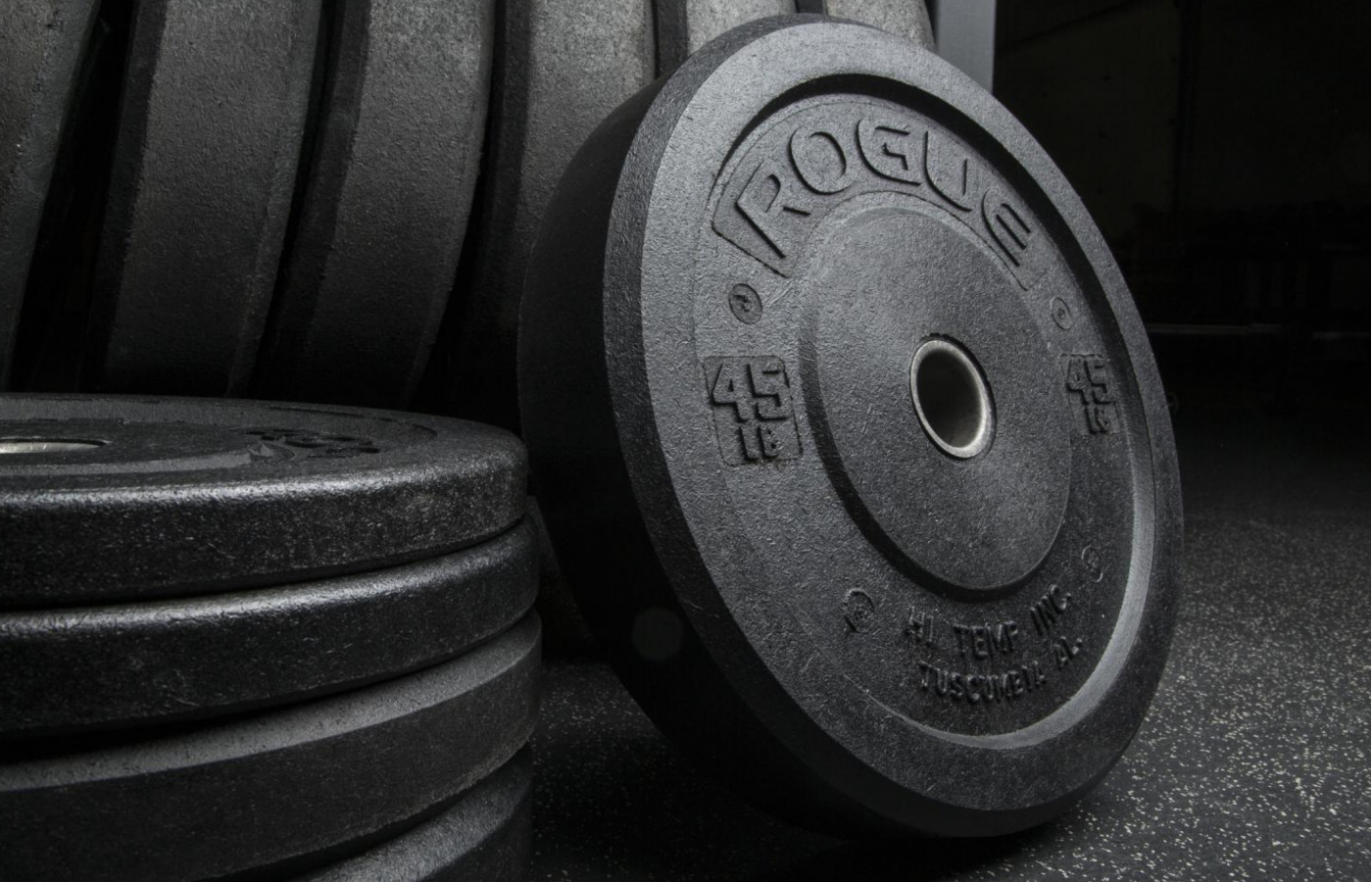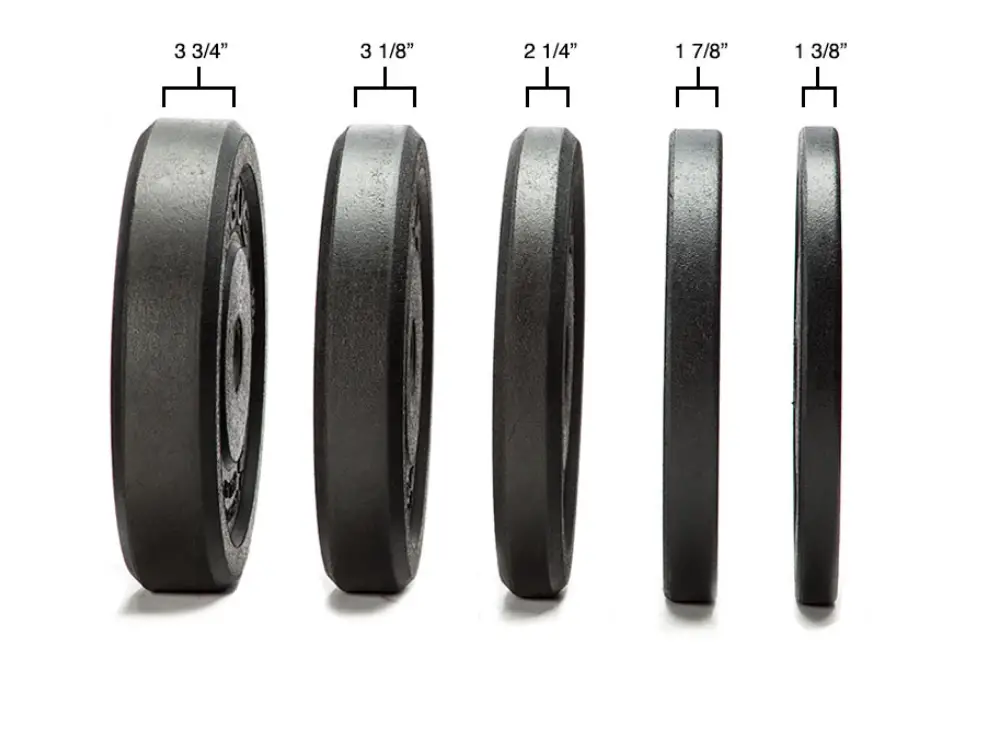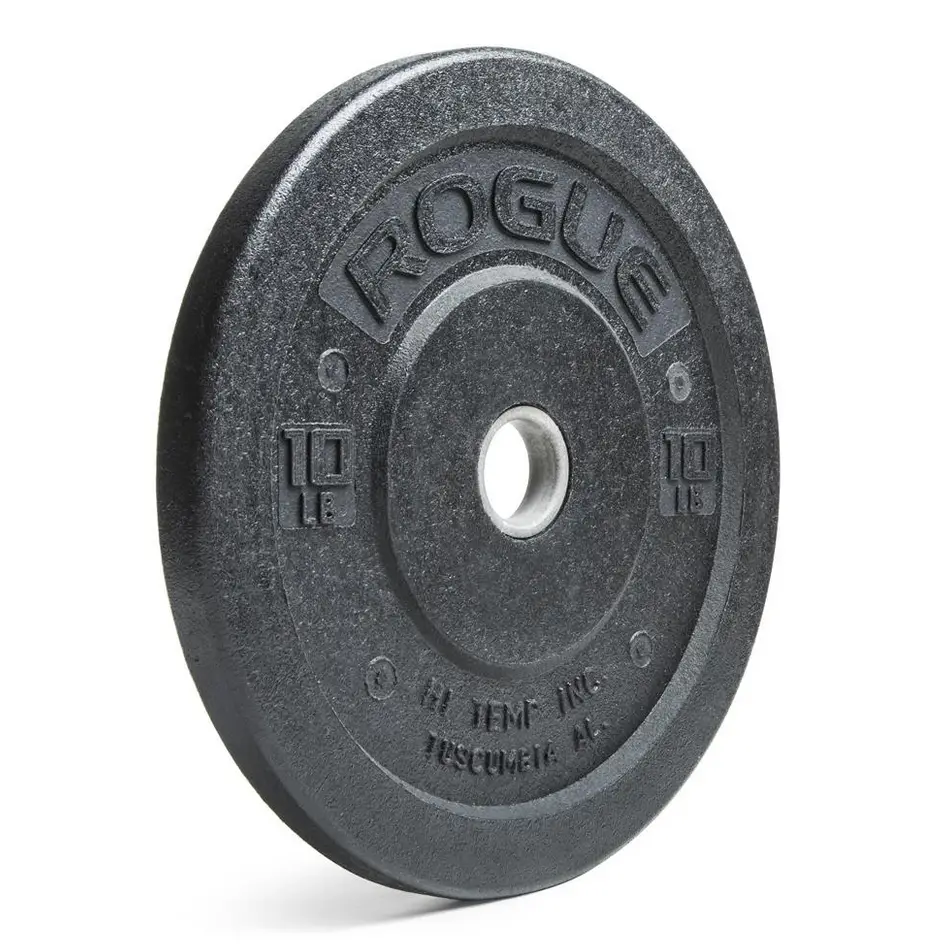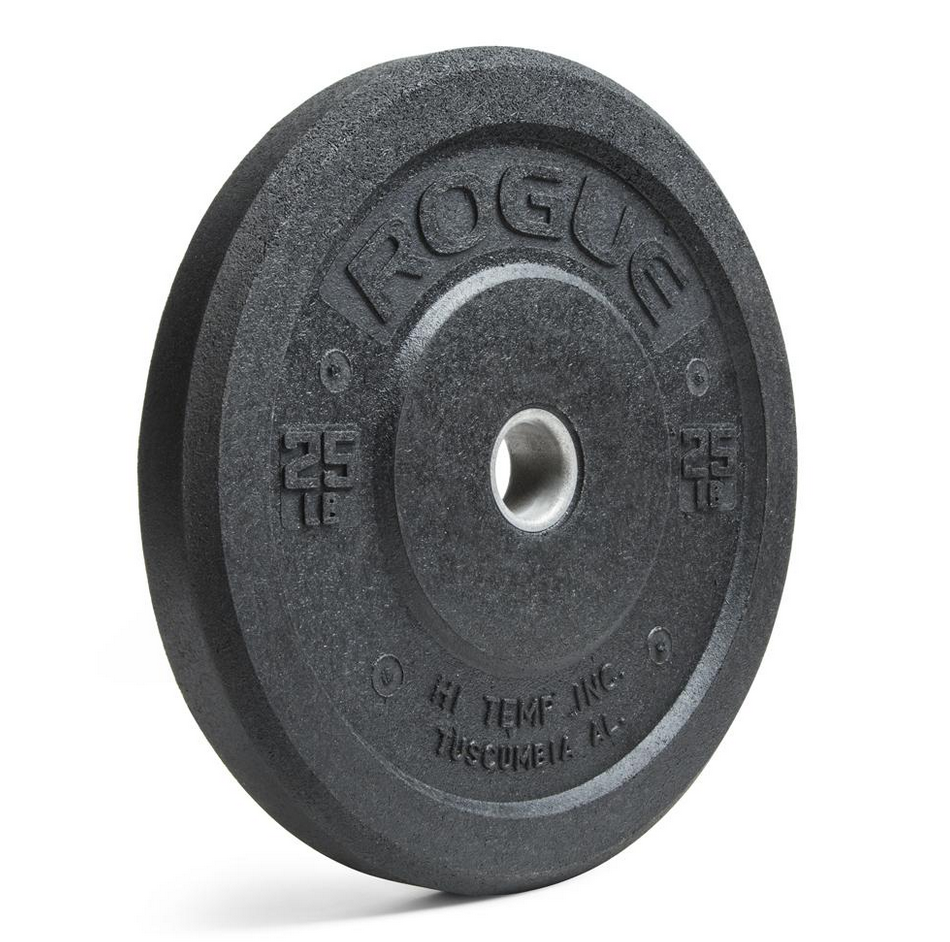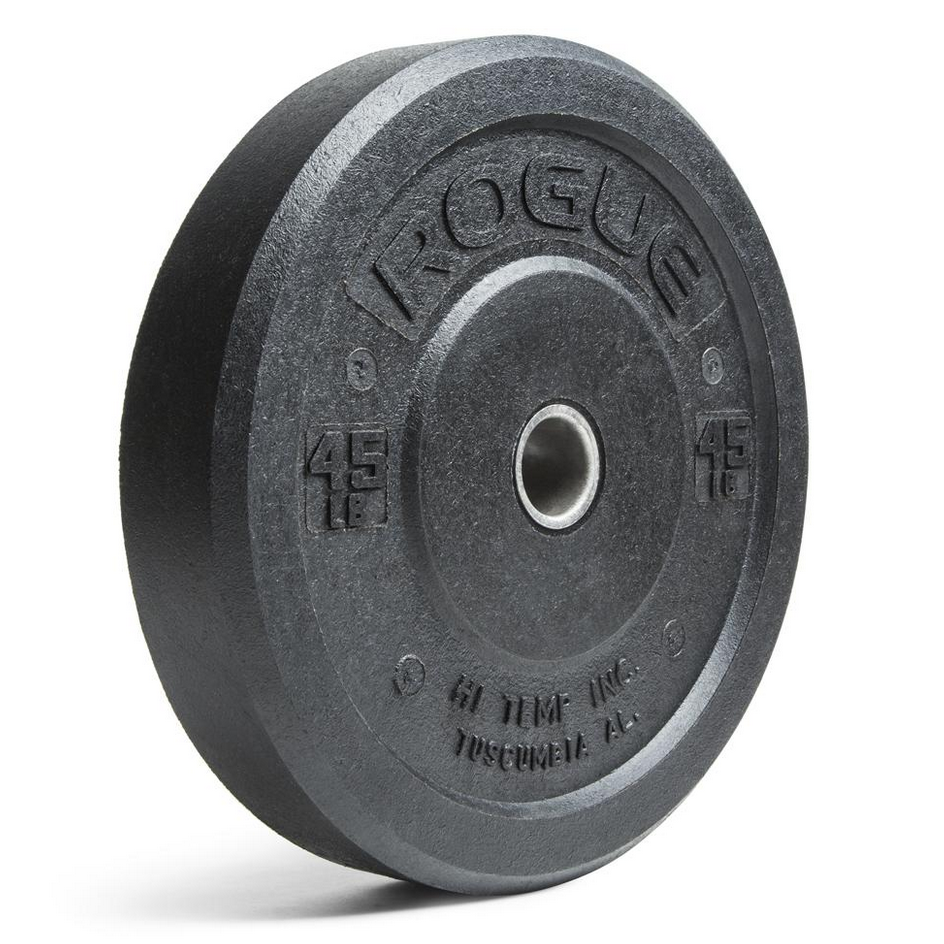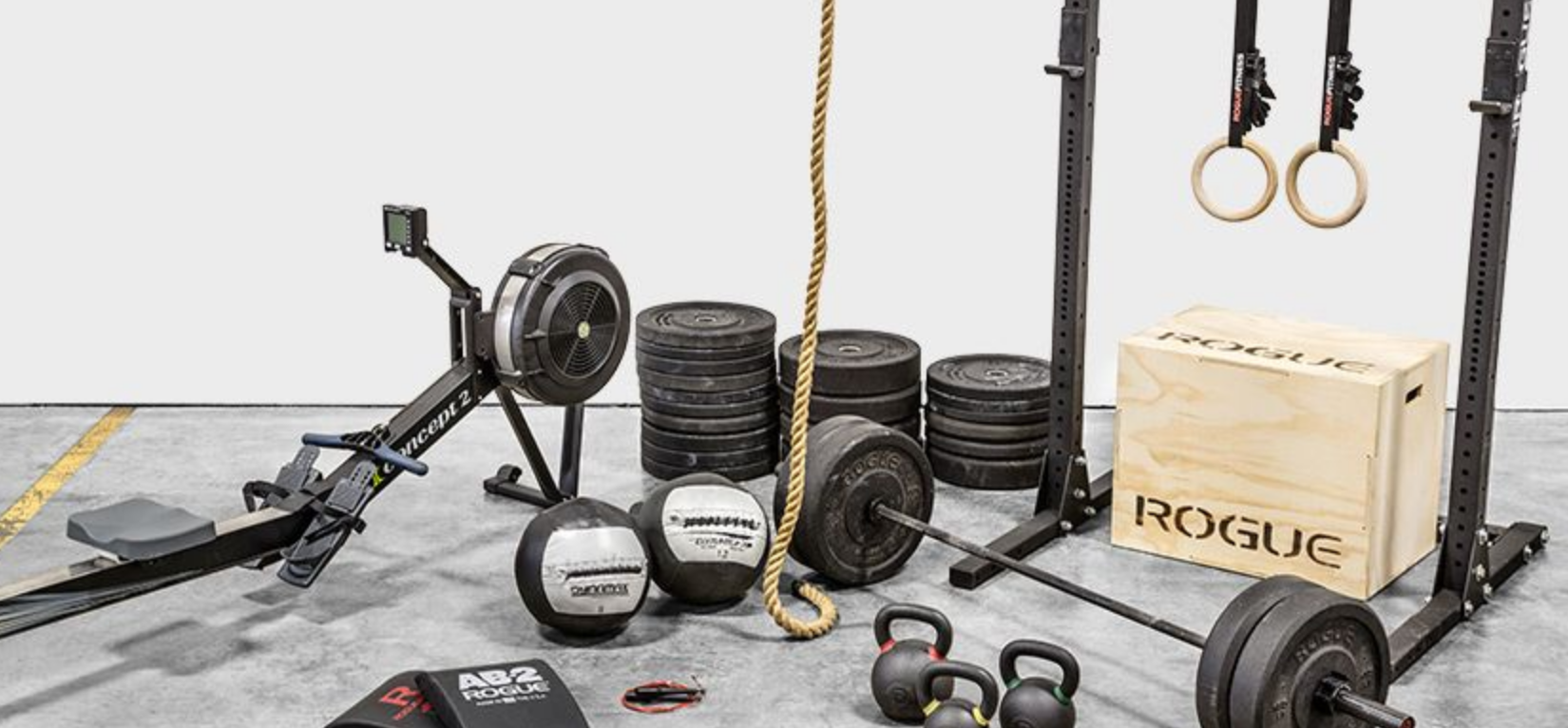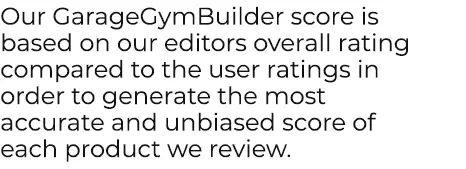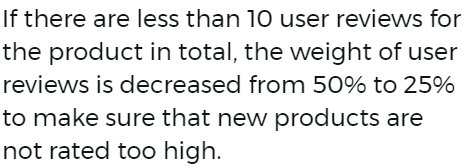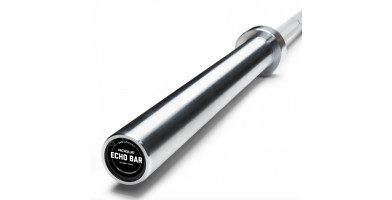Rogue Bumper Plates by Hi-Temp
Editor’s Conclusion
The epic war continues to rage on between lifters that love Rogue bumper plates, and those that love that classic clank of Rogue cast iron plates. Bumper plates have some pretty killer advantages, but they clock in at a pretty stiff price point. If you are building a pure powerlifting gym, you will most likely want to stick with your cast iron plates (and I probably could never convince you to give up that satisfying clank of the iron anyway).
If you are engaging in quick and speedy CrossFit lifts, these bumper plates from Rogue are a must-have. They are coated in a layer of rubber that will help to protect your floor when you fail out on a clean and press or deadlifts. They have a high level of bounce, which gives you an added level of confidence when failing out on a set. These plates are manufactured in the United States and are composed of high-quality crumb rubber that is designed to stand the test of time. They clock in at a pretty steep price point but are the last set of plates you will ever need to buy.
Below, I wanted to dive into all of the details as to why these plates are perfect for your home gym.
If you are engaging in quick and speedy CrossFit lifts, these bumper plates from Rogue are a must-have. They are coated in a layer of rubber that will help to protect your floor when you fail out on a clean and press or deadlifts. They have a high level of bounce, which gives you an added level of confidence when failing out on a set. These plates are manufactured in the United States and are composed of high-quality crumb rubber that is designed to stand the test of time. They clock in at a pretty steep price point but are the last set of plates you will ever need to buy.
Below, I wanted to dive into all of the details as to why these plates are perfect for your home gym.
Editor's Pros & Cons
Pros
Great bounce won’t chip your floors
More affordable than cast iron
Made from crumb rubber
Manufactured in the United States
Same diameter regardless of weight
Ideal for high-rep circuits or CrossFit
Cons
Expensive
The wide frame is difficult to quickly load and unload
Not color-coded
Strong rubber odor, even after years of use
Wide frame is difficult to grab onto
Key Features
MATERIALS
These plates are made from crumb rubber that is manufactured in the United States. Unlike budget-friendly cast iron plates that use sand to fill or solid metals inside of their plates, these bumper plates are composed of 100 percent rubber. They also have a steel plate insert to make it a little easier and efficient to slide it on and off your Olympic-sized barbell. The rubber materials used in these plates give you the confidence to drop your clean and press on the floor of your basement or garage without doing any damage.
One thing that I noticed about these plates is that they have a very distinct rubber odor that just never quite goes away. Some lifters have been using these plates for over 2 years and found that their home gym still smells faintly of rubber. If you are lifting in your garage, however, this odor won’t be much of an issue! Personally, I actually like the smell of rubber so it doesn’t bother me too much.
USE
One of the most important things that I want to discuss is the use of these plates. If you are building a dedicated powerlifting gym, this style of plates may not be ideal for you. Their main function is to bounce once they hit the floor so you can engage in quick movements, and powerlifting is more about slow and calculated movements. I suggest investing more in classic plates if powerlifting is your jam.
If you are into circuit training or CrossFit, these plates are well worth every penny. There is nothing quite as satisfying as dropping a heavy clean and press on the floor when it is over your head so you can quickly move on to your next exercise. These plates are incredibly bouncy, which means that you can confidently drop them on the floor. Injuries often occur during the dismount of a heavy lift (I once tweaked my back on the dismount of a deadlift), so being able to just drop the weight at the top of your lift is not only satisfying, it also helps to prevent injuries as well!
WEIGHT OPTIONS
I love that Rogue gives you quite a few weight packages to choose from. If you are starting from scratch and need a little bit of everything, they offer comprehensive weight packages to get you started. The most comprehensive set includes weights up to 1,000 pounds. Rogue allows you to pick and choose how those 1,000 pounds are broken down. You can break it down into all 45 pounds plates, or mix and match between 10, 15, 25, 35, and 45-pound plates.
If you are looking for supplemental weights or just want to give these unique rubber plates a try, Rogue also offers single sets in the 10, 15, 25, 35, and 45-pound increments. I suggest picking up a single pair of plates to get started and to gauge how well you like them before making the pretty serious and expensive investment in an entire set.
PRICE
While the price tag is quite expensive, you can save yourself a bit of money by investing in these rubber plates as compared to the calibrated cast-iron plates offered in the Rogue store. I compared the 45-pound plate set back-to-back and was surprised to find that the cast-iron plates clock in at about 75 dollars higher than the rubber plates.
While the bumper plates will save you a little bit of money, it is important to note that they won’t provide you the same satisfying clank of steel, and they aren’t quite as durable.
DUROMETER
The durometer scale indicated just how much bounce a material has. The scale ranges from 0 to 100, with 0 being very soft and bouncy, and 100 being less bouncy and hard. These bumper plates clock in at a 75 on the bounce scale, which is pretty standard across the board when comparing them to other bumper plates out there on the market.
When dropped from over your head after a clean and press, these plates bounce back up just about to the base of your knee cap. When compared to other brands, the Rogue design doesn’t bounce and more or any less.
SIZE
Another thing that makes bumper plates unique is that they come in various thicknesses. The 45-pound plate is the thickest of the Rogue bumpers, and it measures to be 3 ¾ inches thick. This higher thickness makes it a little more difficult to wield and load than your average cast-iron plate, but it is pretty standard across the board when compared to bumpers from other brands. The 10-pound plate measures to be 1 ⅜ inch thick, the 15 is 1 ⅞ inch thick, the 25 is 2 ¼ inches thick, and the 35 is 3 ⅛ inches thick.
They also measure to be 445MM in diameter across the board, which is unique to only bumper plates. When dealing with cast-iron plates, the 45-pound plate is the only one that measures to be 445MM in diameter. All of the other plates are smaller in diameter. If you want to deadlift but haven’t worked your way up to a pair of 45s, a set of bumper plates is a great place to start, because you won’t need to bend as low to the ground to grip the bar.
These plates are made from crumb rubber that is manufactured in the United States. Unlike budget-friendly cast iron plates that use sand to fill or solid metals inside of their plates, these bumper plates are composed of 100 percent rubber. They also have a steel plate insert to make it a little easier and efficient to slide it on and off your Olympic-sized barbell. The rubber materials used in these plates give you the confidence to drop your clean and press on the floor of your basement or garage without doing any damage.
One thing that I noticed about these plates is that they have a very distinct rubber odor that just never quite goes away. Some lifters have been using these plates for over 2 years and found that their home gym still smells faintly of rubber. If you are lifting in your garage, however, this odor won’t be much of an issue! Personally, I actually like the smell of rubber so it doesn’t bother me too much.
USE
One of the most important things that I want to discuss is the use of these plates. If you are building a dedicated powerlifting gym, this style of plates may not be ideal for you. Their main function is to bounce once they hit the floor so you can engage in quick movements, and powerlifting is more about slow and calculated movements. I suggest investing more in classic plates if powerlifting is your jam.
If you are into circuit training or CrossFit, these plates are well worth every penny. There is nothing quite as satisfying as dropping a heavy clean and press on the floor when it is over your head so you can quickly move on to your next exercise. These plates are incredibly bouncy, which means that you can confidently drop them on the floor. Injuries often occur during the dismount of a heavy lift (I once tweaked my back on the dismount of a deadlift), so being able to just drop the weight at the top of your lift is not only satisfying, it also helps to prevent injuries as well!
WEIGHT OPTIONS
I love that Rogue gives you quite a few weight packages to choose from. If you are starting from scratch and need a little bit of everything, they offer comprehensive weight packages to get you started. The most comprehensive set includes weights up to 1,000 pounds. Rogue allows you to pick and choose how those 1,000 pounds are broken down. You can break it down into all 45 pounds plates, or mix and match between 10, 15, 25, 35, and 45-pound plates.
If you are looking for supplemental weights or just want to give these unique rubber plates a try, Rogue also offers single sets in the 10, 15, 25, 35, and 45-pound increments. I suggest picking up a single pair of plates to get started and to gauge how well you like them before making the pretty serious and expensive investment in an entire set.
PRICE
While the price tag is quite expensive, you can save yourself a bit of money by investing in these rubber plates as compared to the calibrated cast-iron plates offered in the Rogue store. I compared the 45-pound plate set back-to-back and was surprised to find that the cast-iron plates clock in at about 75 dollars higher than the rubber plates.
While the bumper plates will save you a little bit of money, it is important to note that they won’t provide you the same satisfying clank of steel, and they aren’t quite as durable.
DUROMETER
The durometer scale indicated just how much bounce a material has. The scale ranges from 0 to 100, with 0 being very soft and bouncy, and 100 being less bouncy and hard. These bumper plates clock in at a 75 on the bounce scale, which is pretty standard across the board when comparing them to other bumper plates out there on the market.
When dropped from over your head after a clean and press, these plates bounce back up just about to the base of your knee cap. When compared to other brands, the Rogue design doesn’t bounce and more or any less.
SIZE
Another thing that makes bumper plates unique is that they come in various thicknesses. The 45-pound plate is the thickest of the Rogue bumpers, and it measures to be 3 ¾ inches thick. This higher thickness makes it a little more difficult to wield and load than your average cast-iron plate, but it is pretty standard across the board when compared to bumpers from other brands. The 10-pound plate measures to be 1 ⅜ inch thick, the 15 is 1 ⅞ inch thick, the 25 is 2 ¼ inches thick, and the 35 is 3 ⅛ inches thick.
They also measure to be 445MM in diameter across the board, which is unique to only bumper plates. When dealing with cast-iron plates, the 45-pound plate is the only one that measures to be 445MM in diameter. All of the other plates are smaller in diameter. If you want to deadlift but haven’t worked your way up to a pair of 45s, a set of bumper plates is a great place to start, because you won’t need to bend as low to the ground to grip the bar.
Comparison to Cast-Iron Plates
Instead of comparing these basic bumpers to previous versions (which there are none- Rogue got it right the first time around!), I wanted to give a good back-to-back comparison to cast-iron plates. One of the biggest differences between bumpers and cast iron is the bounce. If you are powerlifting and engaging in slow, 1 rep movements, cast iron is your best bet. This style of plate is more durable over time, and gives you that classic clank that really gets your blood pumping!
Bumper plates are designed more for lifters that are going to high reps at high speed as you see in CrossFit or speedy circuits. Bailing at the top of a lift not only keeps your workout humming along at a speedy pace, but also prevents injuries that often occur when dismounting.
Rubber plates also come in universal diameters that measure to be 445MM, unlike cast iron that varies in diameter based upon weight. This can be incredibly beneficial when you are just starting out with deadlifts and haven’t quite reached 45 pounds. If you pop on a pair of shallow 25-pound cast iron plates, you will need to bend down a lot deeper to engage in your deadlift.
Bumper plates are designed more for lifters that are going to high reps at high speed as you see in CrossFit or speedy circuits. Bailing at the top of a lift not only keeps your workout humming along at a speedy pace, but also prevents injuries that often occur when dismounting.
Rubber plates also come in universal diameters that measure to be 445MM, unlike cast iron that varies in diameter based upon weight. This can be incredibly beneficial when you are just starting out with deadlifts and haven’t quite reached 45 pounds. If you pop on a pair of shallow 25-pound cast iron plates, you will need to bend down a lot deeper to engage in your deadlift.
Verdict
The war between cast-iron and bumper plates wages on, but it is up to you to determine if they are right for your home gym. What I love most about these Rogue Bumper plates is that they are composed of quality materials that hold up well over the years, and clock in at a price point that is slightly less expensive than Rogue calibrated cast-iron plates. They lack that beloved clank of iron when loading up the bar, but it’s up to you whether or not it is a deal-breakers.
I would recommend these plates for lifters that like to engage in high reps, low weight circuits, or CrossFit training. The high bounce of these plates won’t break or damage your concrete floors when failing under a lift. While I suggested that they be used by lifters looking for high-intensity lifts, they also work well for powerlifters that are concerned about chipping their floors when engaging in deadlifts as well!
I would recommend these plates for lifters that like to engage in high reps, low weight circuits, or CrossFit training. The high bounce of these plates won’t break or damage your concrete floors when failing under a lift. While I suggested that they be used by lifters looking for high-intensity lifts, they also work well for powerlifters that are concerned about chipping their floors when engaging in deadlifts as well!

